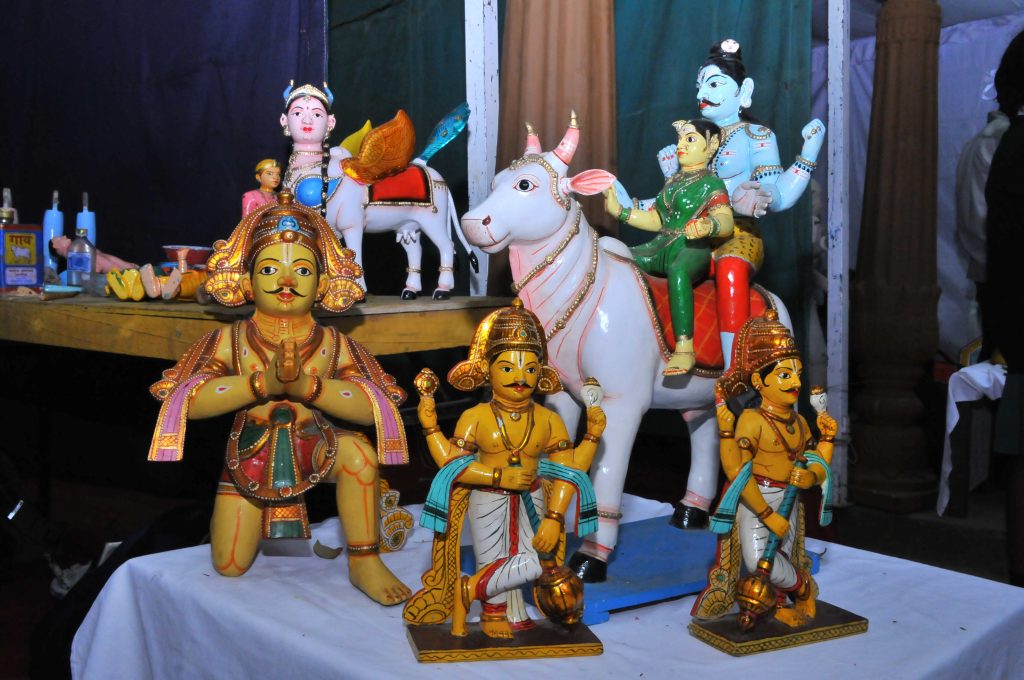The Koppal Toy Cluster (KTC) has taken up efforts to support the small number of artisans still involved in making Kinnal Toys which date back to the 15-16th century.

The ancient art form of Kinnal had been in decline for many years, but thanks to the efforts of government agencies and the support of Aequs, the artisans of Kinnal have been able to revive their craft.
Located in the village of Kinhal in the Koppal district of Karnataka, India, Kinnal art has its roots in the 15th-16th centuries, during the rule of the Vijaynagara Empire. Craftspeople from across India were invited to come and work in the capital city of Hampi, where they created beautiful murals and intricate wooden carvings for the temples and palaces.
The famous mural paintings in the Pampapateshwara Temple, and the intricate work on the wooden chariot at Hampi, were completed by ancestors of the Kinnala artists of today. The wooden idols of Kinnala have been accorded a Geographical Indication (GI tag number 159). A GI is a sign used on products that have a specific geographical origin and possess qualities or a reputation that are due to that origin.
Today, there are still over 60 artisan families in Kinnal, but only 25 of them are actively involved in the traditional art form. The rest have either moved to other cities or taken up different trades. Some have even started making toys out of modern materials like plaster of paris (POP) or other woods.
Of the 25 active families, only five can make a full-time living off their Kinnal art. The work is extremely time-consuming and requires a great deal of skill, which is why many artisans have chosen to diversify.
Fortunately, government agencies have been working to help the Kinnal artisans get organized and improve their livelihoods.
The Koppal Toy Cluster (KTC), the first toy manufacturing cluster I India set up by Aequs, has also been supporting for the artisans through its corporate social responsibility (CSR) initiatives. It is primarily helping them market their wares globally as also showcasing their products to its own customers who constitute some of the biggest toy brands from across the world.
How it is made
The artists carefully chisel the wood, creating the initial shape of the idol. This is followed by mixing liquid tamarind and pebble paste, which is applied it to the wood shape to give it a smooth surface. As the idol dries, the finer details are added while carving out the delicate features.

For larger pieces, the artists make different components separately and then join them together using a special mixture of ground tamarind seeds, wood powder, and thin jute strands. A paste of pebble powder and liquid gum to attach the embossed patterns, including the jewelry, to the idol.
Once the idol is complete, the artist applies layers of cloth soaked in tamarind paste to coat the figure. This gives it a smooth and polished finish. Finally, the artist paints the idol in white, using chalk powder, and then adds the vibrant colors of red, green, blue, and yellow.
In some cases, the artists use a rare technique to create a shiny gold finish on the idol. This involves applying a mixture of beaten zinc and herbs directly to the wood, without the use of fabric. This technique is time-consuming and costly, and only a few families still practiced it.
Despite the challenges, the artists are proud of their work and the beautiful idols they create. Not surprisingly, every toy is a unique piece of art crafted with careful care and love by the small number of Kinnalla artisans.
Clearly, a disappearing art form that needs to be supported seriously.
